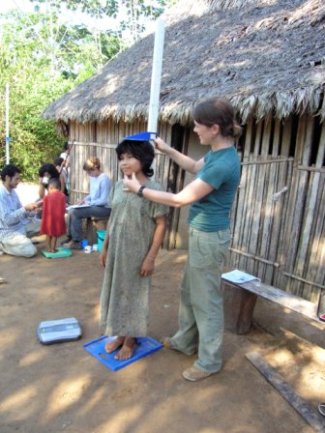Relationship between Growth Stunting and Body Composition

It is estimated that about 165 million children worldwide are growth stunted, or short for their age, compared to international growth references. High rates of stunting are a well-recognized signal of stressful conditions during childhood growth as stunting often stems from malnutrition and infection. Anthropology and nutritional sciences have also shown that poor growth early in life has longer-term consequences as children and infants who are stunted grow up to be shorter adults with reduced muscle mass and possibly permanent metabolic changes. Understanding how stunting is related to later-life patterns of body fat may provide insights into why populations experiencing rapid lifestyle changes such as urbanization or shifts in diet and daily activities also experience rising obesity rates.
In order to provide additional information on the short-term consequences of stunting, we examine the relation between height and several measures of body composition among children and adolescents living in the Bolivian Amazon. We draw on a sample of 483 Tsimane’ youth ages 2-10 years that measured height, weight, skinfold measures of body fat, and arm muscularity annually across a six year period (2002-2007). We use multilevel regression models with age and sex adjusted measures of Body Mass Index (BMI), skinfold measurements, and muscle mass as outcome variables and stunting during the first year of the study as the primary explanatory variable.
As is unfortunately common through many indigenous South American groups, childhood stunting is common among Tsimane’ youth. We find that stunting at the beginning of the study, when participating children were between 2 and 7 years of age, is associated with lower levels of body fat and arm muscularity across 6 years. While there is a stronger relation between stunting and reduced body fat among girls than boys, both boys and girls who were stunted had lower measures of arm muscularity across the study period than their non-stunted peers. The consequences of stunting were stronger among older children and robust to sensitivity analyses that control for variables capturing household and community environment.
Overall, these finding are consistent with research suggesting that early growth restriction permanently constrains muscle development and modifies body fat patterns through adolescence and points to the important role of the environment in shaping human growth and population health.
References
Tanner, Susan; Leonard, William R.; Reyes-García, Victoria; TAPS Bolivia Study Team. The consequences of linear growth stunting: Influence on body composition among youth in the Bolivian Amazon. American Journal of Physical Anthropology 153: 92-102. 2014.


